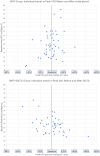Impact of sodium-glucose cotransporter-2 inhibitor use on peak VO2 in advanced heart failure patients
- PMID: 39114558
- PMCID: PMC11303302
- DOI: 10.3389/fcvm.2024.1376645
Impact of sodium-glucose cotransporter-2 inhibitor use on peak VO2 in advanced heart failure patients
Abstract
Introduction: Advanced heart failure (HF) is an epidemic that affects multiple organ systems with high morbidity and mortality rates despite optimal medical therapy (OMT) and remains the leading cause of hospitalizations in type 2 diabetes-related cardiovascular disease. The addition of sodium-glucose co-transporter inhibitors (SGLT2i) in treating these patients has seen improved mortality and hospital admission rates. As such, we felt it was important to investigate whether the use of SGLT2i improved functional capacity in patients with HF when compared to OMT by evaluating maximum oxygen consumption (peak VO2) using cardiopulmonary exercise testing (CPET).
Methods: We found 94 heart failure patients between August 2020 and August 2021 who underwent CPET before and after treatment at Mayo Clinic in Florida. 50 patients received OMT and 44 received OMT and SGLT2i therapy. CPET results before and after were compared for each group.
Results: The baseline ejection fraction was not significantly different between groups, with the OMT group at 38% and the SGLT2i group at 33%, p = 0.10. OMT patients were found to have a significantly lower hemoglobin A1c of 5.7 (5.4-6.1) compared to those with SGLT2i therapy of 6.4 (5.8-7.1), p = 0.01. The baseline peak VO2 was 17.3 ml/kg/min (13.3-21.6) in the OMT group and 17.3 ml/kg/min (14.4-18.9) in the SGLT2i group, p = 0.18, not significantly different. The interesting finding is that the follow-up peak VO2 at one year for the OMT group was 17 ml/kg/min (13.3-21.6), which was not significantly different from the SGLT2i group peak VO2 of 17 ml/kg/min (14.6-19.6), p = 0.19. Our study is the first to compare before and after peak VO2 values of the OMT+SGLT2i group to the patient's own baseline and we found no significant improvement.
Conclusion: Our single-center data shows no improvement in functional capacity after the addition of SGLT2i therapy to OMT in patients with advanced heart failure. Improved hospitalization and symptoms may be attributed to other numerous effects of SGLT2i such as volume management.
Keywords: CPET; SGLT2i; VO2; diabetes; exercise test; functional capacity; heart failure; transplant.
© 2024 Desai, Sharma, Abuah, Jang, Desai, Paghdhar and Goswami.
Conflict of interest statement
The authors declare that the research was conducted in the absence of any commercial or financial relationships that could be construed as a potential conflict of interest.
Figures





Similar articles
-
Potential Hematopoietic Effects of SGLT2 Inhibitors in Patients with Cardiac Amyloidosis.Rev Cardiovasc Med. 2025 Mar 20;26(3):26081. doi: 10.31083/RCM26081. eCollection 2025 Mar. Rev Cardiovasc Med. 2025. PMID: 40160567 Free PMC article.
-
Impact of SGLT2 Inhibitor Therapy on Right Ventricular Function in Patients with Heart Failure and Reduced Ejection Fraction.J Clin Med. 2022 Dec 21;12(1):42. doi: 10.3390/jcm12010042. J Clin Med. 2022. PMID: 36614843 Free PMC article.
-
Sodium-Glucose Cotransporter 2 Inhibitors First Strategy Improve Decongestion in Patients with Symptomatic Heart Failure and Reduced Ejection Fraction When Compared to Angiotensin Receptor Neprilysin Inhibitor First Strategy.Front Biosci (Landmark Ed). 2023 Apr 27;28(4):81. doi: 10.31083/j.fbl2804081. Front Biosci (Landmark Ed). 2023. PMID: 37114551
-
Effects of different sodium-glucose cotransporter 2 inhibitors in heart failure with reduced or preserved ejection fraction: a network meta-analysis.Front Cardiovasc Med. 2024 May 23;11:1379765. doi: 10.3389/fcvm.2024.1379765. eCollection 2024. Front Cardiovasc Med. 2024. PMID: 38845687 Free PMC article.
-
Effect of sodium-glucose cotransporter-2 inhibitors on cardiac remodelling: a systematic review and meta-analysis.Eur J Prev Cardiol. 2022 Feb 3;28(17):1961-1973. doi: 10.1093/eurjpc/zwab173. Eur J Prev Cardiol. 2022. PMID: 34792124
References
-
- Bonora BM, Vigili de Kreutzenberg S, Avogaro A, Fadini GP. Effects of the SGLT2 inhibitor dapagliflozin on cardiac function evaluated by impedance cardiography in patients with type 2 diabetes. Secondary analysis of a randomized placebo-controlled trial. Cardiovasc Diabetol. (2019) 18:106. 10.1186/s12933-019-0910-5 - DOI - PMC - PubMed
LinkOut - more resources
Full Text Sources
Research Materials
Miscellaneous

